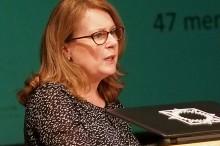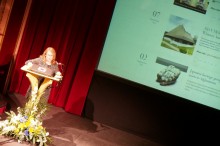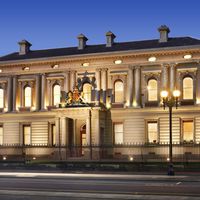ASEMUS Chair Participates in The Best in Heritage
 The 2015 edition of the international conference The Best in Heritage was held in Dubrovnik, Croatia, between 24 and 26 September. The event gathered 130 museum and heritage professionals from 37 countries, who had the opportunity to present and learn about several success stories.
Among the participants was ASEMUS Chair Fionnuala Croke, who presented the aims and activities of the Asia-Europe Museum Network. Following the event we interviewed her, in order to know more about the experience.
Q: Could you briefly describe the context of the conference, and the main issues that were addressed
The Best in Heritage conference started 14 years ago, and is always held in the beautiful old city of Dubrovnik. This was my first time to attend it and I greatly enjoyed both the programme and the people I met there. Over two days, 28 heritage projects from all over the world were presented: they included small community initiatives and big picture plans from large museums. What connected them all was that they had been deemed projects of influence and that they represented innovation.
Q: What was ASEMUS' role in that context? And how can participation in "The Best in Heritage" contribute to the network's future activities?
At the end of the first day, there was an opportunity for a couple of projects to be ‘spotlighted’ and here I had the opportunity to present the ASEMUS network to the delegates. A number of attendees commented to me later. The network was previously unknown to them but they found it of interest. Several wondered whether their museums were already members, or were represented on the VCM website. As a number of other networks were present as supporters of The Best in Heritage, namely representatives from Europa Nostra and ICOM, there was a general appreciation for the relevance of ASEMUS. One museum representative had a particularly interesting proposal that I hope may bear fruit in the future.
Q: Among the case studies and experiences presented during the conference, were there any that you found particularly remarkable?
I found a number of the case studies moving, inspirational and remarkable. I will mention just two that struck me as significant.
The 2015 edition of the international conference The Best in Heritage was held in Dubrovnik, Croatia, between 24 and 26 September. The event gathered 130 museum and heritage professionals from 37 countries, who had the opportunity to present and learn about several success stories.
Among the participants was ASEMUS Chair Fionnuala Croke, who presented the aims and activities of the Asia-Europe Museum Network. Following the event we interviewed her, in order to know more about the experience.
Q: Could you briefly describe the context of the conference, and the main issues that were addressed
The Best in Heritage conference started 14 years ago, and is always held in the beautiful old city of Dubrovnik. This was my first time to attend it and I greatly enjoyed both the programme and the people I met there. Over two days, 28 heritage projects from all over the world were presented: they included small community initiatives and big picture plans from large museums. What connected them all was that they had been deemed projects of influence and that they represented innovation.
Q: What was ASEMUS' role in that context? And how can participation in "The Best in Heritage" contribute to the network's future activities?
At the end of the first day, there was an opportunity for a couple of projects to be ‘spotlighted’ and here I had the opportunity to present the ASEMUS network to the delegates. A number of attendees commented to me later. The network was previously unknown to them but they found it of interest. Several wondered whether their museums were already members, or were represented on the VCM website. As a number of other networks were present as supporters of The Best in Heritage, namely representatives from Europa Nostra and ICOM, there was a general appreciation for the relevance of ASEMUS. One museum representative had a particularly interesting proposal that I hope may bear fruit in the future.
Q: Among the case studies and experiences presented during the conference, were there any that you found particularly remarkable?
I found a number of the case studies moving, inspirational and remarkable. I will mention just two that struck me as significant. The presentation on the Museum of Innocence in Istanbul was memorable. The concept of creating both a novel and a museum simultaneously so that each exists because of the other, and each fulfils the other, is something new and remarkable. Orhan Pamuk is the author of the novel and the curator of the museum where all the objects on display illustrate chapters from the novel, conjuring up memories and evoking atmosphere.
At the other end of the scale, I was impressed by the presentation by the Children’s Museum in Indianapolis. What most impressed me was the extent to which this museum has sought to engage directly with its surrounding community, its neighbours. This is something all museums seek to do to some extent, but in Indianapolis they have gone a step beyond. They are in the fortunate position of being well endowed and they have used their resources to provide low interest loans to the low income communities adjacent to their museum, and have even created housing schemes. This is their way of ‘giving back’ to the neighbourhood they live and thrive in.
The presentation on the Museum of Innocence in Istanbul was memorable. The concept of creating both a novel and a museum simultaneously so that each exists because of the other, and each fulfils the other, is something new and remarkable. Orhan Pamuk is the author of the novel and the curator of the museum where all the objects on display illustrate chapters from the novel, conjuring up memories and evoking atmosphere.
At the other end of the scale, I was impressed by the presentation by the Children’s Museum in Indianapolis. What most impressed me was the extent to which this museum has sought to engage directly with its surrounding community, its neighbours. This is something all museums seek to do to some extent, but in Indianapolis they have gone a step beyond. They are in the fortunate position of being well endowed and they have used their resources to provide low interest loans to the low income communities adjacent to their museum, and have even created housing schemes. This is their way of ‘giving back’ to the neighbourhood they live and thrive in.
ASEMUS was a media partner of the 2015 edition of The Best in Heritage. For additional information about the conference and its results, please visit http://www.thebestinheritage.com/news/best-in-heritage-2015
Similar content
24 Sep 2015 - 26 Sep 2015
from - to
22 Sep 2016 - 24 Sep 2016
22 Sep 2016 - 24 Sep 2016
26 Sep 2018 - 28 Sep 2018

